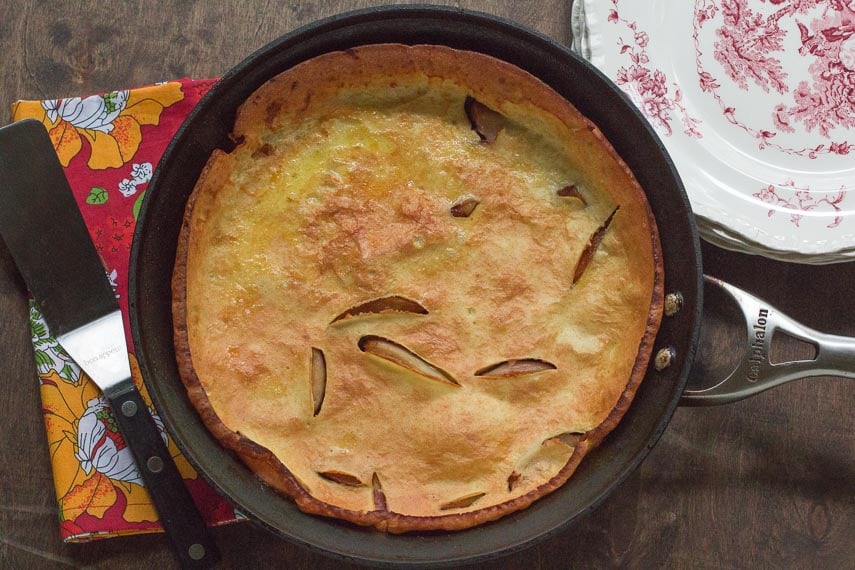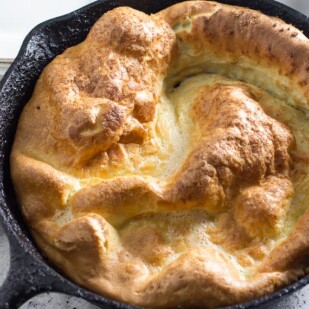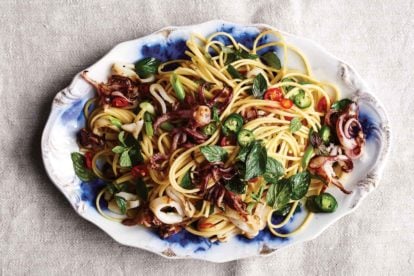Learn How to Make Low FODMAP Dutch Baby Pancakes
If you are looking for a more classic approach to the beloved Dutch Baby Pancake, be sure to check out that recipe, which we re-made into a low FODMAP version. Here we have our Low FODMAP Ginger Peach Dutch Baby Pancake!
White Peaches – A Low FODMAP Portion
This recipe takes advantage of the fact that we can have white peaches in 18 gram (2/3 ounce) portions. This does mean that you will have to divide this Ginger Peach Dutch Baby Pancake into 4 portions.
If you have yellow peaches around, you can increase the peach amount as yellow peaches are low FODMAP in 30 g portions. See the image below.
What does 18 grams of white peach look like? See below, along with the 40 g of mango on the left and 5 g of black plum on the right – all low FODMAP portions.
Be Ready to Eat
As soon as this pancake is done – and I mean the very moment it is done – it is time to serve it!This is a pancake that doesn’t hold well. It will begin to deflate as soon as you remove it from the oven.
It will still taste great – but you will lose out on the drama.
The very high heat of the oven and the egg-rich batter puffs in a very similar way to popovers, another one of our classic low FODMAP baking recipes.
Check out our Recipe Filter for many more delicious baked goods, just ready for your low FODMAP lifestyle.
You will need lactose-free milk for this recipe, which you can buy or DIY! We have an article that shows you how!

Low FODMAP Ginger Peach Dutch Baby Pancake
This Low FODMAP Ginger Peach Dutch Baby Pancake is say to make and is perfect for a low FODMAP breakfast or brunch.
Ingredients:
- 2 tablespoons unsalted butter, cut into pieces
- 72 g (generous 2 ½ ounces) of sliced white peaches, skin on or peeled
- 1 tablespoon firmly packed light brown sugar
- 1/4 teaspoon ground ginger
- 2 large eggs
- 1/2 cup (120 ml) lactose-free whole milk
- 1/2 cup (120 ml) low FODMAP gluten-free flour, such as Bob’s Red Mill 1 to 1 Gluten-Free Baking Flour
- Pinch Kosher salt
Preparation:
-
Position rack in upper third of oven. Preheat oven to 450°F/230°C.
-
Place the butter in a 10 to 12-inch (25 cm to 30.5 cm) ovenproof skillet and melt over medium heat. Add white peaches, brown sugar and ginger and sauté, stirring often, for about 5 minutes or until peaches are softened and a bit caramelized.
-
Whisk eggs well in a mixing bowl. Add milk, flour and salt and whisk together well. Pour the batter into the hot skillet and immediately place in oven.
-
Turn heat down to 425°F/220°C and bake for 12 to 15 minutes or until Ginger Peach Dutch Baby is puffed and golden brown. Remove from oven and serve immediately, divided into 4 servings.
Notes:
Tips
- I have tried this Dutch Baby recipe with alt milks, such as almond milk, and cannot promote the results. The resulting pancake ends up being quite flat and dense.
Nutrition
All nutritional information is based on third-party calculations and should be considered estimates. Actual nutritional content will vary with brands used, measuring methods, portion sizes and more. For a more detailed explanation, please read our article Understanding The Nutrition Panel Within Our Recipes.












Oh this looks perfect! I do react to peaches and have found 2oz of peaches is my tolerance level, but if the color of the peach makes a difference I am soooo willing to retest my tolerance with this over brunch!.🤗P,s. For me peaches trigger the CRPS pain in my body ,which in turn left me with the gut issues . The Low Fodmap diet has helped quite a bit! Thank you for the tips. tricks, and recipes posted on Fodmap Everyday! This website is such a blessing!
Linda, thank you for taking the time to write! So glad we have been able to help.